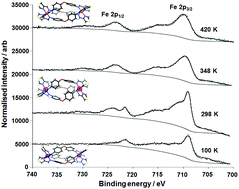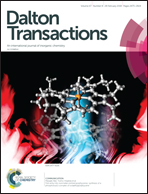Direct monitoring of spin transitions in a dinuclear triple-stranded helicate iron(ii) complex through X-ray photoelectron spectroscopy†
Abstract
A dinuclear helical iron(II) complex of a new ditopic thiazolylimine ligand (L) has been synthesised via supramolecular assembly. The resulting dinuclear helical cylinder [Fe2L3]·4BF4 was investigated by variable temperature X-ray crystallography, ESI high resolution mass spectrometry, CHN analysis, FT-IR and UV-Vis spectroscopy. The nature of the spin transition was investigated by magnetic susceptibility measurements, and confirmed by VT-SCXRD and X-ray photoelectron spectroscopy. [Fe2L3]·4BF4 displays a complete spin transition with a gradual-abrupt character at T1/2 = 348 K and represents a new example of a dinuclear iron(II) complex exhibiting a spin transition at high temperature. Both VT-SCXRD and XPS measurements show excellent correlation with the magnetic susceptibility experiments, demonstrating the power of XPS not just to confirm, but also to clearly follow the spin-state transition in Fe(II) SCO complexes.



 Please wait while we load your content...
Please wait while we load your content...